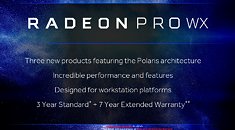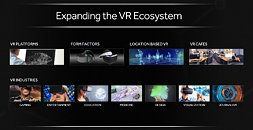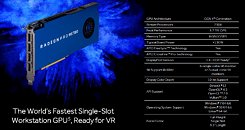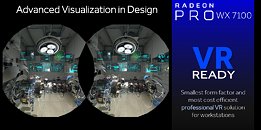Raevenlord
News Editor
- Joined
- Aug 12, 2016
- Messages
- 3,755 (1.20/day)
- Location
- Portugal
| System Name | The Ryzening |
|---|---|
| Processor | AMD Ryzen 9 5900X |
| Motherboard | MSI X570 MAG TOMAHAWK |
| Cooling | Lian Li Galahad 360mm AIO |
| Memory | 32 GB G.Skill Trident Z F4-3733 (4x 8 GB) |
| Video Card(s) | Gigabyte RTX 3070 Ti |
| Storage | Boot: Transcend MTE220S 2TB, Kintson A2000 1TB, Seagate Firewolf Pro 14 TB |
| Display(s) | Acer Nitro VG270UP (1440p 144 Hz IPS) |
| Case | Lian Li O11DX Dynamic White |
| Audio Device(s) | iFi Audio Zen DAC |
| Power Supply | Seasonic Focus+ 750 W |
| Mouse | Cooler Master Masterkeys Lite L |
| Keyboard | Cooler Master Masterkeys Lite L |
| Software | Windows 10 x64 |
At its WX call, AMD focused on shifts in creativity from traditional design flows such as Solidworks, Adobe and Autodesk towards game engines as solutions for design visualization (Unreal Engine, Unity, CryEngine, or Autodesk's own Stingray platform), which signal changes in the creator ecosystem. Thanks to globalization, the Internet, and the available wealth of knowledge one can access through it, the line between amateurs and professionals is becoming more and more blurred. Now, those who would once be called amateurs are also using professional tools, and AMD plans to be at the forefront of technologies empowering creators to deliver their vision.
Radeon PRO serves to give creators more flexible and powerful solutions, leveraging open-source resources and centering the ecosystem back on creators and the tools they choose to use, with focused support on VR. As such, AMD is giving them the tools they need, by introducing three new products featuring the Polaris architecture, including 3 year standard + 7 year free extended warranty (including components such as the PCB itself, the PCI-Express slot, and the heatsinks), with AMD taking that extra 7 years as company commitment towards the quality of their products. Those three products are the WX4100, the WX5100, and the WX7100, and have planned, staggered availability throughout November.



Under the hood, these products bring the Polaris GPU (through its Baffin and Ellesmere parts) into the professional workspace, leveraging 14nm FinFet, 4th Gen GCN, up to 5k HDR, Displayport 1.4, and True Audio Next support.

The WX4100 brings an MSRP of $399, delivering up to 2.4 TFLOPS, up 1 TFLOP from AMD's equivalent previous-generation product it replaces in the stack. It features TDP under 50W, packing 1024 Stream processors and 8GB GDDR5 into a half-height bracket graphics card (with full height brackets also available). AMD says it's ready for all the typical workstation flows, but more specifically, CAD applications.


The WX5100, on the other hand, comes in at $499, delivering up to 3.9 TFLOPS of computing power, at under 75 W power, which makes it slightly more efficient, in pure power/performance ratios, than the WX4100. AMD states that the WX5100 was developed to tackle all the traditional workflows, for professionals working with more resource-consuming models, equipping the WX5100 with a larger framebuffer, 1792 Stream Processors, and the same 8GB GDDR5 memory. This solution offers higher gaming engine environment performance than the WX4100 - Bioshock Infinite was benchmarked running at 53 FPS average @2560*1440, and an average of 35 FPS @ 4K.


Finally, on to the latest and meanest member of the WX family that has been announced: the WX7100, which AMD touts as being the world's fastest single-slot workstation GPU, and one more geared towards VR workflows. This product enables the full Polaris 10 graphics chip, packing 2304 Stream Processors and 8GB GDDR5, with peak performance at 5.7 TFLOPS (AMD pointed towards its previous-generation, Fiji-based W9100, which delivered 5.24 TFLOPS as comparison). Another comparison points are the TDP, with the WX7100's standing at <130 W (less than half the <275 W on the W9100), and pricing: coming in at under 799$, the WX7100 stands as an upper middle-range product delivering more than the performance of previous-generation flagships, at 1/4 of the price (with the W9100 costing $3999 at launch, though it did offer an extra 8GB GDDR5 memory).



View at TechPowerUp Main Site
Radeon PRO serves to give creators more flexible and powerful solutions, leveraging open-source resources and centering the ecosystem back on creators and the tools they choose to use, with focused support on VR. As such, AMD is giving them the tools they need, by introducing three new products featuring the Polaris architecture, including 3 year standard + 7 year free extended warranty (including components such as the PCB itself, the PCI-Express slot, and the heatsinks), with AMD taking that extra 7 years as company commitment towards the quality of their products. Those three products are the WX4100, the WX5100, and the WX7100, and have planned, staggered availability throughout November.



Under the hood, these products bring the Polaris GPU (through its Baffin and Ellesmere parts) into the professional workspace, leveraging 14nm FinFet, 4th Gen GCN, up to 5k HDR, Displayport 1.4, and True Audio Next support.

The WX4100 brings an MSRP of $399, delivering up to 2.4 TFLOPS, up 1 TFLOP from AMD's equivalent previous-generation product it replaces in the stack. It features TDP under 50W, packing 1024 Stream processors and 8GB GDDR5 into a half-height bracket graphics card (with full height brackets also available). AMD says it's ready for all the typical workstation flows, but more specifically, CAD applications.


The WX5100, on the other hand, comes in at $499, delivering up to 3.9 TFLOPS of computing power, at under 75 W power, which makes it slightly more efficient, in pure power/performance ratios, than the WX4100. AMD states that the WX5100 was developed to tackle all the traditional workflows, for professionals working with more resource-consuming models, equipping the WX5100 with a larger framebuffer, 1792 Stream Processors, and the same 8GB GDDR5 memory. This solution offers higher gaming engine environment performance than the WX4100 - Bioshock Infinite was benchmarked running at 53 FPS average @2560*1440, and an average of 35 FPS @ 4K.


Finally, on to the latest and meanest member of the WX family that has been announced: the WX7100, which AMD touts as being the world's fastest single-slot workstation GPU, and one more geared towards VR workflows. This product enables the full Polaris 10 graphics chip, packing 2304 Stream Processors and 8GB GDDR5, with peak performance at 5.7 TFLOPS (AMD pointed towards its previous-generation, Fiji-based W9100, which delivered 5.24 TFLOPS as comparison). Another comparison points are the TDP, with the WX7100's standing at <130 W (less than half the <275 W on the W9100), and pricing: coming in at under 799$, the WX7100 stands as an upper middle-range product delivering more than the performance of previous-generation flagships, at 1/4 of the price (with the W9100 costing $3999 at launch, though it did offer an extra 8GB GDDR5 memory).



View at TechPowerUp Main Site
Last edited:





